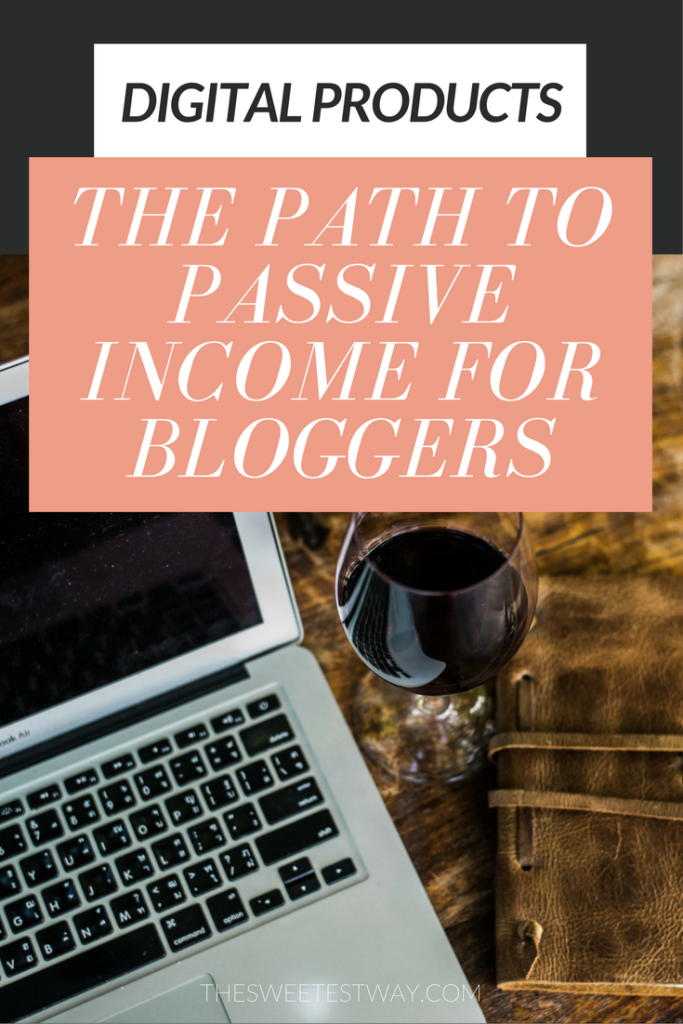My goal with this blog, beyond sharing travel stories, is to explain my various methods for earning money online so that others who are interested in creating a location independent lifestyle have the tools to do so (and can avoid making the same mistakes I did).
Today, I’m focusing on creating digital products, which is something I strongly believe every blogger should do. In fact, you don’t even need a blog to begin selling digital products.
Related post: 12 Creative Ways to Make Money Online Without a Blog
I created my e-book in 2016, and it’s a resource for becoming location independent. To download a free sample chapter, enter your info below.
Digital products create a revenue stream that can pay off for many years after the initial effort. Moreover, once you get the right system (sales funnel) in place, your digital products will essentially sell on auto-pilot, creating a source of passive income.
Why more bloggers don’t sell digital products, I’ll never know. We all have something to teach; we all have knowledge that someone else considers valuable. All you have to do is zero in on what that knowledge is and how to package it appropriately, and you’re well on your way to making a living as a professional content creator.
Launch your own #digitalproducts to start earning #passiveincome as a blogger Click To TweetE-Book or E-Course?
When creating digital products, you must first consider how to best present the material. The easiest route is to create an e-book. This way of presenting knowledge requires little more than written material which you can easily convert to a downloadable PDF. People can purchase it and instantly receive it, and then consume the material at their leisure. It can be a great starter product to get people on your email list and introduce them to your brand.
An e-course, on the other hand, requires considerably more work. Ideally, you will present information in a written format but also in interactive formats such as video lessons and downloadable worksheets. To successfully run a course, you must also commit to a higher level of support for your students. The online courses I’ve been a part of typically offer to answer questions by email or in online forums, or they run a private Facebook group where students can ask questions and receive direct support from the course creator.
Another thing to consider is your level of knowledge on your chosen topic. E-books can be quite short with a narrow focus and sold at a very low price point. They can also be longer and offer more in-depth information. An e-course, however, should always be comprehensive and offer students a wealth of knowledge on the topic at hand. It should contain action steps–ways that students can grow and develop as they work through the material. E-books can simply be informative, but an e-course should help people solve a real-life problem.
Finally, consider your income goals. An e-book will likely never create a generous source of income for you, for a few reasons. For one, people will not value an e-book as highly as they will value an e-course, even if the information presented is nearly identical. Secondly, because your book would have a lower price point than a course, you would need to generate a high volume of sales each month.
To use my own e-book as an example, at $18 per book, I can sell 20 copies in a month and only make $360. While not an insignificant amount of money, it only makes a dent in my living expenses. On the other hand, I could hypothetically price an e-course at $200, meaning I’d only need 5 sales each month to generate $1000 in revenue. Ten new students would mean $2000, and so on. Then consider that you can offer tiered pricing on your e-course, allowing students to upgrade to get more personalized feedback from you or any other add-ons you may choose.
As your blog traffic and email list continue to grow, it’s easy to see how selling an e-course could quickly become a full-time income whereas an e-book would only provide supplemental income. In summary, creating an online course is a very involved process that will take much more time and effort than writing an e-book, but the potential long-term payoffs are much greater.
It’s up to you to determine which digital products will help you meet your business goals.
Creating Digital Products: Lessons Learned & Mistakes to Avoid
My Digital Product: What Went Right
My first digital product launch was successful in plenty of ways. Because I had never done anything like this before, there was a lot of room for error–with that in mind, I was fairly pleased with how it went and prefer to think of it as a learning experience, the lessons from which I will carry into my next product launch.
I validated the idea before I created my e-book
Some of the best advice I’ve heard for creating digital products is to wait for your readers to ask you to create something. Listening to your audience and getting feedback from them is the best way to figure out what they want.
In the years leading up to my e-book release, I’d gotten email after email from readers asking how I created a life that allowed me to travel so often. After writing reply after reply explaining how I got my various freelancing gigs or how I was making money through my blog, I realized I could elaborate on this information to create a valuable resource.
The common underlying question was: “How can I create a life like yours?”
So, armed with that knowledge, I settled on the topic of my e-book, which was how to become location independent.
Learn more about my e-book, Take Your Life Back: Finding Freedom Through Location Independence.
But the topic validation didn’t stop there…
I pre-sold the book to my email list at a low introductory price
Once I had the book idea in mind, I announced it to my email list to gauge their interest. Several people pre-ordered a copy, reinforcing that I was on the right track. Pre-selling a product before you’ve started creating it is one of the best validation methods you can possibly employ.
I priced it low in the beginning, explaining that it was an introductory price that wouldn’t be around forever (to create urgency). Those first copies sold for just $6.99, which was probably too low even then, but it definitely gave me some much-needed confidence.
I created a targeted email list
Once I knew my existing subscribers were interested in the e-book, I started gathering new leads. This meant adding email opt-in forms to all blog posts relevant to the topic of location independence, with the incentive being that they would be the first to know about the book’s release and have access to early-bird pricing. BOOM. New validation from highly targeted customers.
I began positioning myself as an expert
I began writing more and more on the topic of location independence as a way of positioning myself as an expert. I talked all about what the lifestyle meant to me, who it was right for, and the greatest lessons I’d learned from living this lifestyle. Each of these posts helped me spread the word about my upcoming product launch and gather new leads.
In addition to writing for my own blog, I guest posted on other sites (and have continued to do so since the book’s release) to gain wider exposure and more leads.
I launched on-time
I announced that the product would be released on July 20th, roughly three months from when I began working on it. In hindsight, I should have given myself more time, but in the end, I was able to release it on the right date, shipping out the first copies to the people who had pre-ordered it at the introductory price.
If you tend to procrastinate, I highly suggest giving yourself strict deadlines for finishing each draft and your final launch date.
I hired a professional photographer
For this e-book, I knew I wanted to include stunning visuals that would accurately represent myself and my brand, so I enlisted the help of my good friend and photographer Megan.
The photos that resulted from our evening shoot tied the book together beautifully and have since been used over and over again in the continued marketing of the product. This was by far the biggest investment I made in creating the e-book, but I made the money back in no time.
If I were to create an e-course in the future, I would most certainly be investing in professional video editing services as well, since this is one of my weak points and the time it would save me would be enormous.
When creating a digital product, you may have to spend money to make money–attempting to DIY the whole thing yourself could result in tons of added time and stress on your part, and a lower-quality end product that ultimately doesn’t sell as well. Don’t be afraid to outsource and trust that the investment will pay off.
The end design was beautiful
Once I had all the written material and photos ready, I just had to format the book. At first, I assumed I would simply outsource this as well, but then I discovered iBooks Author and designed the whole book myself, for free.
Again, if you’re not a design whiz or you’re short on time, you may just want to outsource your book design. But I found iBooks Author to be fairly intuitive to use and finished putting it all together in just a few days. Plus, I have the original file to edit and update, which allowed me to put out the second edition this year, again without having to go through a designer.
iBooks Author is available for free download in the Mac App Store and comes with several templates to choose from, which you can then customize to fit your needs.
For creating e-courses, Teachable is a popular service that offers a beautiful user experience.
I sold the product through Gumroad
There are many ways to sell a product online, but I used Gumroad from the very start (a free service, unless you want to upgrade for more features) and have been extremely pleased with how simple it’s been.
I can take credit card payments, I can give people discount codes, I can easily track every customer and issue refunds seamlessly. I can embed the product sales information in any page or post. I can see where my referrals are coming from and which affiliates are making sales. My payouts are issued every two weeks by direct deposit.
Check out this post which details Gumroad and some other similar options for selling directly on your blog.
The alternative for an e-book is to sell through Amazon, however, this comes with its own set of drawbacks. Follow this link to determine whether selling on Amazon or your own site is best.
My Digital Product: What Went Wrong
There was a lot of room for improvement in this digital product launch, and I learned from each and every mistake. Take note of what I did wrong so you can avoid these errors, too.
The timing was terrible
It’s time to level with you guys–I was in a really bad place in the month leading up to my product launch. I was traveling like crazy, my relationship was going south, I never felt like I had enough time to blog, much less work on the e-book, and I constantly felt frazzled. I felt like I was in way over my head and like I was failing in every way imaginable.
In hindsight, there’s no way I could have known how challenging that time in my life would be, so I don’t know if there’s much I could have done differently. All I can suggest to others is to carefully consider your launch timeline and recognize any potential conflicts (scheduling or otherwise) long before they happen.
I definitely DON’T suggest traveling while you’re trying to put together a digital product because your travels AND your product will suffer. The product launch should be your primary focus because it’s going to require a lot from you, both physically and mentally.
I had no proper launch strategy
I mentioned above that I had begun collecting new leads for my e-book, but the truth is, I didn’t know how to properly utilize my email list for maximum effect. I should have emailed them with updates far more often than I did, and I should have had automated sequences going out in the meantime.
Additionally, I tried to launch all on my own, which was just the worst thing I could have done. A launch should be a collaborative effort–get your friends and peers involved. Get them copies of the product EARLY and have a beautiful landing page full of testimonials. Give your blogger friends time to review your product so they’re ready to write about it on launch day and share it with their audiences. Offer them affiliate commissions as an incentive. Get your friends and family talking about the product and telling all their friends.
If you’re really on top of your game, you’ll be holding webinars, you’ll be building hype, you’ll be marketing your new product heavily before it launches. I failed to do this in just about every way.
Before I launch my future e-course, I’m learning the ropes in Launch Your Signature Course by Mariah Coz of Femtrepreneur. She’s a true online business expert and generates $100,000+ per month in passive income from selling digital products and courses.
I was scrambling to finish it at the very end
As mentioned above, I should have finished my e-book at least a month before the launch date to give myself (and others) extra time to promote it. Instead, I was still working on it the very night before launch, a mistake I never plan to repeat.
I never had the e-book professionally edited
While I did hire a proofreader to scan for spelling and grammatical errors, I really should have hired a professional editor to work through my content and improve its overall structure, clarity, and flow. This is another mistake I do not plan to make again in the future (and another reason why the writing should have been done well in advance of the launch).
What I’ve Learned Since the Launch
It was all worth it
I launched my first digital product over a year ago now, and have had a lot of time to reflect on the process. While it felt stressful at the time, I’m now only more convinced that I want to build my online business around digital products.
Digital products allow you to provide something truly valuable to your audience. They allow you to build relationships, they allow you to help people and have a positive impact on their lives.
I know how much of an impact digital products have had on my life and business, and I want to provide that for others. Let me tell you–there’s no better feeling in the world than when a happy customer reaches out to thank you for affecting their life positively.
Not to mention that there’s a great sense of pride that comes with creating something from nothing. I know how much of my blood, sweat, and tears went into creating my e-book, and even if I never make another sale, I’ll be proud of the work I put in.
I wish I’d been using ConvertKit
Back when I launched in 2015, I was still using the free email service MailChimp to collect leads. I’ve since switched to ConvertKit and I wish I’d done so a long time ago.
Click here to read why I prefer ConvertKit and why it’s a service worth paying for.
Don’t undervalue your digital products
This year, I added four extra chapters to my e-book and updated several others, and re-launched at a higher price point (64% higher, in fact). I was nervous that no one would buy it at the new price, but in fact, the opposite has proven true.
I see more sales now than I did when I had the book priced lower, which just goes to show that people value your expertise more than you think. Don’t undervalue your digital products!
Now I want to hear from you–have you launched your own digital products? What went right and what went wrong? Let’s learn from each other.



